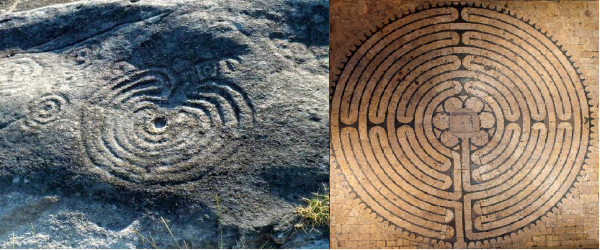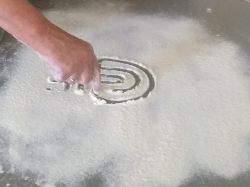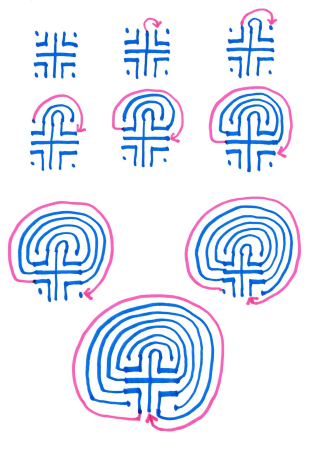AIMS Journal, 2022, Vol 34, No 4
To read or download this Journal as a PDF. Please click here.

By Alex Smith
The twists and turns of the labyrinthine pathway have often been borrowed as a metaphor for the journey into parenthood, and more particularly, for childbirth itself.[1] In this article I offer a brief introduction to the history of the labyrinth, give directions for creating your own, and show how the metaphor can provide reassurance and strength when the journey proves longer and more convoluted than expected.
The word labyrinth, according to many accounts, was first used to refer to the complex underground structure built on Crete by Daedalus, the father of Icarus who flew too near the sun. It was commissioned by King Minos as a home and confinement for the dreaded minotaur[2], a creature who was half man and half bull. However, the classical design of the labyrinth predates those times and may be as old as 4000 years or more.[3] It is believed that the earliest labyrinths were intended to trap evil spirits, and the story of the minotaur may represent the inner demon. However some stone labyrinths have been found near fishing communities, and one (challenged) theory suggests that these may have been fish traps.[4] In later times, the labyrinth is widely understood as a symbol of our journey in life[5] or of a particular spiritual challenge we have to face; not so far removed perhaps from its original meaning. Whatever, their first intended purpose though, it is interesting that it is an archetypal image found in diverse cultures around the world and even adopted by the Christian church.[6]

The Mogor labyrinth in Spain (about 2000 years old)[7], and Chartres Cathedral (13th century).[8]
The broad distinction between a maze and a labyrinth is that the former is multicursal or has many paths, and the latter unicursal being made with a single, albeit convoluted, path. Unlike a maze, it is not possible to become lost in a labyrinth. This single path has been thought to represent a pilgrimage and walking along the path has been used to assist prayer and meditation.[9] In modern times, labyrinths have been incorporated into a range of therapeutic settings because walking the labyrinth is known to be calming and a good way of lowering the symptoms of stress.[10]
To make a labyrinth of your own, you could follow the directions below and mow a labyrinth pathway into your lawn or mark one out on a beach. If your living circumstances are more confined, the benefits are even found by tracing the pathway with your finger. A home-tracing labyrinth could be made in clay with an indented pathway, embroidered, knitted, painted or carved into wood, but a humble pencil, crayon or felt-tip creation is perfect too.

This is how to draw a labyrinth:

The metaphorical meaning of the labyrinth is created as you trace its path. In approaching the threshold of a new adventure (marriage, childbirth, parenthood, a course of study, a new job) people often experience a sense of liminality.[11] This is the feeling you get when you are on the precipice of something new. You haven’t embarked yet, but there is no turning back. Liminality is often an unpleasant feeling ranging from simple ‘butterflies’ to utter terror. It may involve regret for the things being left behind and uncertainty or fear for the future. These feelings are often mixed with ones of excitement and possibility, making this a confusing and unsettling time for many.
The centre of the labyrinth is not the destination. It is the turning point where you find and gather up what it is you need for the next phase of your life. If the labyrinth represents a course of study for example, the certificate may lay at the centre, but this is not, in itself, the bright future you anticipate. What else do you need to make a go of it? In a person’s journey into parenthood, the labyrinth may represent the labour undertaken to bring the baby into the world. What else will you need as you continue to move forwards as the mother or father you want to be?
Immediately on entering the labyrinth it appears that the centre is straight ahead; almost within reach. Initial feelings of confidence are soon tempered, however, by the twists and turns of the pathway. Doubt, even despair may start to creep in. The journey seems so much longer and more convoluted than expected. The path seems to be leading in the wrong direction, the centre moving further away with every step. Can I do this? Am I doing the right thing? Must I face my inner demons?
The great thing about the labyrinth is that this single pathway does take you to the centre. Sometimes it may feel impossibly narrow, sometimes it is wider and easier to navigate, but either way, it does take you there. You cannot get lost. All you need to do, one step at a time, in your own time, is to keep moving forwards; and just when you feel that it may never end, you turn the corner and there you are!
If your journey is into parenthood, when the centre is reached and the baby gathered up, there is barely time for a few deep breaths before the journey back out of the labyrinth has to be faced. This phase expresses the twists and turns of the early weeks and months of motherhood or fatherhood before the eventual reemergence into a new normality - restored and stronger in the process. Apart from your baby (new qualification, job contract or other turning-point achievement), what else would you hope to find on the return journey?
For anyone interested in making connections with ancient mythology, the journey into and back out of the labyrinth has parallels with Inanna’s descent into the underworld, possibly the oldest epic poem known to us. Inanna was the Sumerian queen of heaven and earth, but even with all of her privilege and power, her journey changes everything.[12] The fact that her story, expressed through poetry, has survived from the earliest times and resonates with us still, speaks of the power of art to capture the essence of our human experience.

Inanna-Ishtar's descent into the Underworld taken from Lewis Spence's Myths and Legends of Babylonia and Assyria (1916).[13]
You may find that drawing a tracing-labyrinth proves to be a few minutes of simple fun, or it may form the basis of a rich and enlightening mind-map or piece of personal artwork. Either way - please enjoy!
[1] England P. (2010) Labyrinth of Birth: Creating a Map, Meditations and Rituals for Your Childbearing Year. Birthing from Within Books; Illustrated edition.
[2] Britannica, T. Editors of Encyclopaedia. Minotaur. Encyclopedia Britannica. www.britannica.com/topic/Minotaur
[3] Labyrinthos (2008) www.labyrinthos.net/photopage01.html
[4] Tolkechev V., Tolkechev M. (2019) Secrets of the Solovetsky Labyrinths: Who? Why? When? Dorrance Publishing Co.
[5] AIMS volunteer Danielle Gilmour wrote, “There is a huge park in Calgary called Nose Hill Park and in it we found a labyrinth. At the time, it did indeed make me think about how it represents so many journeys in life - that sometimes it can feel like you're getting further away from where you want to be but if you just put your head down and stick at it you'll get there in the end. Sometimes you have to move away to get to the core.”
[6] Edkins J. (2008) Chartres and other church mazes www.theedkins.co.uk/jo/maze/chartres/index.htm#chartres
[7] Image from: https://turismoriasbaixas.com/en/recursopan1?content=280379871
[8] Image from: www.cathedrale-chartres.org/en/cathedrale/monument/the-labyrinth
[9] AIMS volunteer Nadia Higson wrote, “Many years ago I walked an ancient turf labyrinth at Breamore in the New Forest, and can testify to what a profound and mystical experience it was. One of my favourite memories!”
[10] Gersbach J. Labyrinths Find Their Way onto Hospital Grounds as Paths to Healing. Perm J. 2008 Fall;12(4):77– 80. doi: 10.7812/TPP/08-045. PMID: 21339929; PMCID: PMC3037149.
[11] Editor’s note: Limen is another word for threshold.
[12] Tearle O. (2022) The First Epic Poem: The Descent of Inanna. Interesting Literature website
https://interestingliterature.com/2018/05/the-first-epic-poem-the-descent-of-inanna
[13] A modern illustration depicting Inanna-Ishtar's descent into the Underworld taken from Lewis Spence's Myths and Legends of Babylonia and Assyria (1916). Internet Archive Book Images, No restrictions, via Wikimedia Commons.
The AIMS Journal spearheads discussions about change and development in the maternity services..
AIMS Journal articles on the website go back to 1960, offering an important historical record of maternity issues over the past 60 years. Please check the date of the article because the situation that it discusses may have changed since it was published. We are also very aware that the language used in many articles may not be the language that AIMS would use today.
To contact the editors, please email: journal@aims.org.uk
We make the AIMS Journal freely available so that as many people as possible can benefit from the articles. If you found this article interesting please consider supporting us by becoming an AIMS member or making a donation. We are a small charity that accepts no commercial sponsorship, in order to preserve our reputation for providing impartial, evidence-based information.
AIMS supports all maternity service users to navigate the system as it exists, and campaigns for a system which truly meets the needs of all.